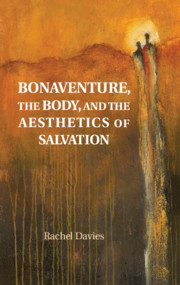Book contents
- Bonaventure, the Body, and the Aesthetics of Salvation
- Bonaventure, the Body, and the Aesthetics of Salvation
- Copyright page
- Dedication
- Contents
- Acknowledgments
- Abbreviations
- Introduction
- 1 Bonaventure’s Aesthetic Vision
- 2 Beauty and the Soul’s Ascent in the Collations on the Six Days
- 3 The Journey of the Body to God
- 4 Transfiguration in the Tree of Life
- 5 Corporeality Reclaimed in The Major Life of Francis
- 6 Paschal Bodies
- Bibliography
- Index
5 - Corporeality Reclaimed in The Major Life of Francis
Published online by Cambridge University Press: 25 November 2019
- Bonaventure, the Body, and the Aesthetics of Salvation
- Bonaventure, the Body, and the Aesthetics of Salvation
- Copyright page
- Dedication
- Contents
- Acknowledgments
- Abbreviations
- Introduction
- 1 Bonaventure’s Aesthetic Vision
- 2 Beauty and the Soul’s Ascent in the Collations on the Six Days
- 3 The Journey of the Body to God
- 4 Transfiguration in the Tree of Life
- 5 Corporeality Reclaimed in The Major Life of Francis
- 6 Paschal Bodies
- Bibliography
- Index
Summary
In preceding chapters I have proposed that while premodern theologians including Bonaventure have tended to emphasize the body’s rebellion against the soul’s headship when speaking of sin’s effect on the human person, in our own period it may be more helpful to emphasize the soul’s abandonment of the body at the fall, together with the whole corporeal world it represents. Journeying to glory under the aesthetic terms initiated by the fall invites humanity to reclaim the corporeality it estranged when it tried to possess created goods divorced from the whole of uncreated Beauty. But this, as we saw in Chapters 3 and 4, can only occur as believers come to locate their bodily diminishment within the glorified corporeality of the resurrected Christ. Relating to diminishment in this way can enable humans to direct the movement of their bodies toward death in a way that leads to transfiguration. While bouts of perplexity and feelings of bodily estrangement may linger (an experience we can read into the ambiguous relationship Francis maintains with his own body throughout the Major Life, as we shall soon see), Bonaventure’s theological framework can teach believers to encounter the unintelligibility of their bodies and of the whole corporeal world with the same tender care Francis exhibits after receiving counsel from the brother just described: “Cheer up Brother Body, and forgive me,” Francis responds, “for I will now gladly do as you please, and gladly hurry to relieve your complaints!” As the body is reclaimed by the soul in this way, the fractured “parts” of fallen humanity may once again come, in hiddenness, to exercise the beauty of proportion, and to participate in the generative work of the One who leads all things to glory.
- Type
- Chapter
- Information
- Bonaventure, the Body, and the Aesthetics of Salvation , pp. 135 - 167Publisher: Cambridge University PressPrint publication year: 2019



